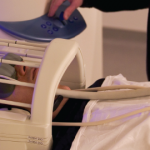
Pain is a subjective experience that cannot be directly accessed by others. Patients in clinical settings and subjects in human pain experiments are often asked to assess pain using scales, such as a numeric rating of 1–10. Although most subjects have little difficulty using these tools, some lack the necessary basic cognitive or motor skills (e.g., paralyzed patients). Also, many factors affect the way we experience pain. A 1 out of 10 for you may equal a 6 out of 10 for your brother. More objective identification of this subjective experience could be very valuable in both treatment and research. In the past couple of decades, scientists around the world have been trying to image how pain changes the brain in order to obtain a more objective read on pain and to gain insight into the mechanisms of pain processing.
Recent research into how pain changes the brain could help rheumatologists develop better treatment for pain and more effective pain-relieving drugs through objective observation of pain.
Marco L. Loggia, PhD, assistant professor of radiology at Harvard Medical School, spoke to The Rheumatologist about functional MRI (fMRI) studies exploring brain activity while patients experienced pain, either by exacerbation of their own clinical pain or by the application of external pain stimuli. fMRI is an imaging technique that can indirectly measure brain function, in addition to showing anatomic structure.
Studies Show…

“Disrupted Brain Circuitry for Pain-Related Reward/Punishment in Fibromyalgia,” the most recent study (January 2014), was published in Arthritis & Rheumatology.1 Thirty-one fibromyalgia patients and 14 controls received calibrated, cuff-pressure pain stimulus on one leg. Cuff pressure was calibrated to each subject’s pain rating of 50 on a 100-point scale. In order to investigate if and how cognitive and hedonic aspects of pain affect neural circuitry, subjects saw visual cues that pain was about to begin and end during the BOLD (blood oxygen level dependent) fMRI scan.
“It was no surprise that [fibromyalgia] patients needed less than half the pressure to have the same brain response to pain as the control subjects,” says Dr. Loggia. What was not as expected was [fibromyalgia] patients’ response to the visual cues that pain was about to start or stop.
During anticipation of both pain and pain relief, fibromyalgia patients demonstrated dampened activation in a widespread set of regions. These regions included the periaqueductal gray (i.e., a region capable of modulating pain signals from the periphery) and the ventral tegmental area (i.e., the region involved in the processing of rewards and punishment signals). Dr. Loggia says, “These dampened activations may be due to patients’ inability to perceive the experimental pain as punishing (because they suffer from their own fibromyalgia pain) and reflect their inability to engage descending pain modulation.”
Blood Flow Changes
Arterial spin labeling (ASL) can directly measure blood flow changes, and it may be superior to BOLD imaging when it comes to investigating certain aspects of clinical pain.2 “While traditional BOLD fMRI can be very effective to measure changes in brain activity due to externally applied pain,” says Dr. Loggia, “ASL seems to be more adequate to measure brain activity associated with the patients’ own clinical pain. This is because BOLD fMRI typically requests the stimulus (in this case the pain) to be rather short in duration (up to a few tens of seconds). Also, ideally the stimuli need to be repeated over and over to achieve a good signal. This, unfortunately, does not work well for clinical pain, because clinical pain cannot be turned on and off at will, and it usually lasts minutes to hours, rather than a few seconds.”
